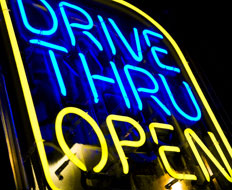Customer service encompasses a multitude of factors. A smiling face and good manners can go a long way to creating a positive impression for any consumer-facing brand, including drive-thru restaurants. But there’s more to it than that.
Drive-thru restaurants competing for the customer dollar have to consider all aspects of the customer experience. It’s not enough to have a great product; queuing times, ease of communication at point of order, accuracy, and speed of order delivery can make or break an establishment’s reputation and have an impact on the bottom line. This isn’t hard to get right. It really all boils down to good communication, and not just with the customer.
Looking at the customer journey through the drive thru, the first contributor to a good or bad experience has to be how long they have to wait to order. If queues build up due to poor communication, their tolerance levels are already being tested before they even get to place an order. Communication systems can help relieve frustration at lane queues with automated greetings, wait-time information, and mechanisms to alert order takers when cars are approaching.
If they’re using drive thru, it’s because they want fast service, and that should be a given. But with most drive thrus achieving tolerable levels of speed, other things come into play, too. No one wants speed at the expense of accuracy or the quality of the order.
Once they’re ready to order, customers want friendly and clear communication. Being able to hear and be heard is essential, no matter how smiley the order-taker is or how hard they are trying to engage with their customer. If the customer can’t hear them properly, it’s just irritating. There is also a real chance the employee will get the order wrong, which is another huge source of aggravation for your customer and a waste of money and time for you (not to mention damage to your reputation).
What’s needed is an effective communication system with noise- and echo-cancelling technology to maximize sound quality for both the customer and the order-taker. This should operate on a duplex platform, meaning both parties can hear each other at all times so there’s no loss of information if the customer decides to change his order, for example. In this way, the customer and order-taker can converse naturally and without stress.
Installing higher-quality audio into the system through the speaker post insures far higher order accuracy and reduction of inaccurate orders. Better still is having order-takers positioned in the lane so they can really engage with their customers and provide a truly personal service. A lightweight, hands-free headset will allow them to take orders accurately and convey them instantly to their colleagues in the kitchen.
Waiting times for food preparation are important, of course, but QSR’s own research in the QSR Drive-Thru Performance Study suggests that while waiting times are key to customer satisfaction, they are not as important as order accuracy. Indeed, there can be something good about having to wait while something is prepared with care, just for you. It suggests you’re getting a quality product. But if it’s the wrong product, that’s a big problem.
The Performance Study identified that the top performer in terms of accuracy has a ranking of 96.4 percent accuracy, which still means that almost 4 percent of the time they get the order wrong. This doesn’t have to happen if every team member is connected to the other through a system that allows them to communicate at will with absolute clarity, wherever they may be in the retail unit. For example, staff in large kitchen areas can use hands-free headset systems to communicate, ensuring orders are fulfilled 100 percent accurately and in timely fashion.
In addition, having teams fully connected wherever they are on the premises means staff can be fully occupied at all times, improving efficiency of the unit. Employees can be called quickly at busy times to take orders, and can be deployed to other areas when it’s quieter.
Keeping customers happy and coming back for more is simply a matter of creating a pleasurable experience, and that means a good product coupled with good communication, not just with the customer, but also with every member of the team.













